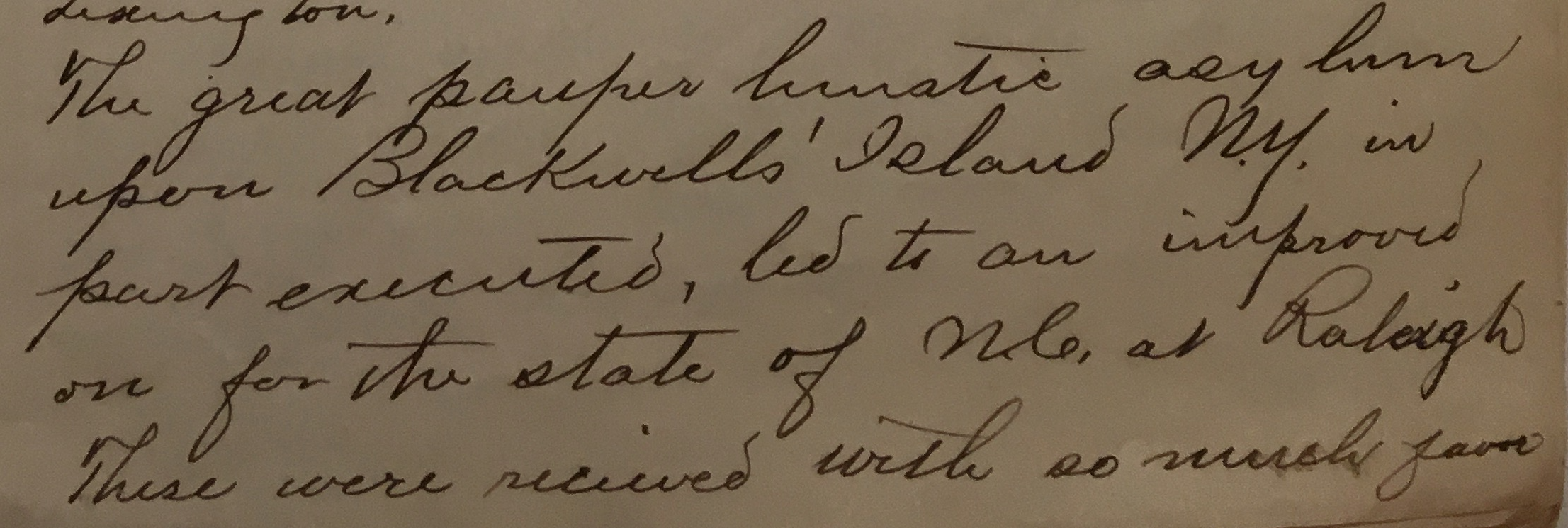The records we have digitized and the datasets derived from them will be hosted in perpetuity through an arrangement with the UNC Odum Institute for Social Science Research (MOU, February, 2020). Controlled access to records and datasets is provided through Odum’s Dataverse portal. There are four different datasets:
- Dorothea Dix Hospital Admissions Ledger Dataset, Patients 0000-7827 (Requires permission to access)
- Dorothea Dix Hospital Records Collection, 1856-1919 (Requires permission to access)
- Minutes of the Eugenics Board of North Carolina, 1958-1964 (Requires permission to access)
- Anna Cameron Kirkland Papers, 1832-1890, and undated
Due to the sensitive nature of these historical records, the first three datasets require permission to access. Permission can be requested through the Dataverse portal.
Data Analysis
The transcribed and digitized admission ledgers and general case books now represent more than 500,000 data points and more than 7,000 patient admissions between 1856 and 1918. Led by graduate research fellow Nate Nihart, we are creating a relational database, which will facilitate management of the data, and greatly expand the range and complexity of questions we can pose, as well as the ways in which the data can be visualized.
Throughout our engagement with these data, they have provoked many questions at multiple levels of analysis: from individuals and families to groups of patients assigned the same “supposed cause” or “form”—within the same patient cohort or over time. Many other questions arise from the burgeoning scholarly literature on the asylum movement (and its aftermath); historical conceptions of the mind, brain, and body; psychiatric diagnoses, etiology, treatment, and outcome.
For nearly two years, Dr. Rose Mary Xavier and the graduate students in her “X Lab” in the School of Nursing have collaborated with the CHW in the transcription of general case book records. By spring 2021, we had a dataset covering the period 1908-1918, which we could align with admission ledgers and patient interviews (1916-1917). One of the readings for our graduate research seminar that semester was Richard Noll’s book, American Madness: the Rise and Fall of Dementia Praecox, the first book-length account in fifty years of what is regarded as the nosological precursor to schizophrenia. Noll details how dementia praecox was introduced in 1896 and within twenty years had become the most common psychiatric diagnosis in American asylums. Defined in relation to its onset, course, and outcome, the diagnosis of dementia praecox was dire: with no cure or effective treatments (Noll calls this the phase of “therapeutic nihilism” in American psychiatry) and with an irreversible progression of psychotic episodes, it all too often meant a long-term custodial “sentence” in the asylum.
The diagnostic foil to dementia praecox in the early twentieth century was manic depression, which some see as the diagnostic precursor to bipolar disorder. It was first called “recurrent mania,” or “cyclical insanity”—an oscillation between manic and depressive episodes (which could be separated by months or years) that were not necessarily progressive. By 1916 nearly half of all patients admitted were assigned one of these two diagnoses. We discovered that the apex of dementia praecox/manic depression corresponded to the tenure of Dix superintendent Albert Anderson, who assumed the role in 1913.
Led by CHW teammate Leah Tams, we created and reviewed a subset of admission ledger and general case book records for all patients diagnosed with dementia praecox, some 190 individuals. Our colleagues in the “X-Lab” are currently analyzing these records. We have also created a dataset for those diagnosed with manic depression—approximately four hundred records—and will add it to the dementia praecox set. Together they represent nearly half of the psychiatric diagnoses made between 1910 and 1918.
Analysis & Visualization
UNC epidemiologist Nab Dasgupta analyzed historic Dix Hospital admissions ledger data, which can be found here. Using this cleaned data, Katie Huber created complex and compelling visualizations, which can be found here.
